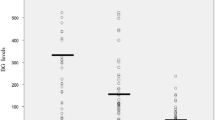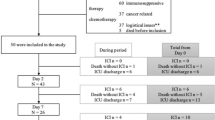Abstract
Introduction
Invasive fungal disease (IFD) remains a significant cause of morbidity and mortality in critically ill patients.
Methods
Examination of 1,3-β-d-glucan (BDG) for IFD and as outcome parameter in immunocompromised critically ill patients with septic shock.
Results
Thirty-two (69 %) out of 46 included patients had BDG beyond the cutoff of >80 pg/ml (mean 320 pg/ml). Twelve (37 %) had findings of Aspergillus spp. in BAL (mean BDG 413 pg/ml). EORTC/MSG guidelines classified these as probable invasive aspergillosis (IA)/IFD. Five (16 %) had candidaemia (mean BDG level 361 pg/ml). Sensitivity of 78 % (95 % CI 58–88 %) and specificity of 68 % (95 % CI 52–77 %) for IFD were found on the BDG Fungitell assay. In detail, a sensitivity of 73 % (95 % 58–84 %) and specificity of 83 % (95 % CI 68–93 %) for IA and a sensitivity of 77 % (CI 95 % 62–87 %) and specificity 53 % (95 % CI 37–73 %) for candidaemia were found. APACHE II, SOFA score and mortality rate were in the elevated BDG group significantly altered (26 vs. 21, p < 0.003; 15 vs. 13, p < 0.006; 72 vs. 50 %, p < 0.004).
Conclusion
1,3-β-d-glucan assay is helpful for early detection of IFD; moreover, elevated BDG levels can be used as a predictor for outcome in immunocompromised critically ill patients as presented in our study.
Similar content being viewed by others
References
Dellinger RP, Levy MM, Rhodes A, et al. Surviving Sepsis Campaign: international guidelines for management of severe sepsis and septic shock, 2012. Surviving Sepsis Campaign Guidelines Committee including The Pediatric Subgroup. Intensive Care Med. 2013;39(2):165–228.
Linde-Zwirble WT, Angus DC. Severe sepsis epidemiology: sampling, selection, and society. Crit Care. 2004;8:222–6.
Dombrovskiy VY, Martin AA, Sunderram J, et al. Rapid increase in hospitalization and mortality rates for severe sepsis in the United States: a trend analysis from 1993 to 2003. Crit Care Med. 2007;35:1414–5.
Vincent JL, Rello J, Marshall J, et al. EPIC II Group of Investigators. International study of the prevalence and outcomes of infection in intensive care units. JAMA. 2009;302(21):2323–9.
Steinbach WJ, Marr KA, Anaissie EJ, et al. Clinical epidemiology of 960 patients with invasive aspergillosis from the PATH Alliance registry. J Infect. 2012;65(5):453–64.
Cornely OA, Gachot B, Akan H, et al. EORTC Infectious Diseases Group. Epidemiology and outcome of fungemia in a cancer cohort of the Infectious Diseases Group (IDG) of the European Organization for Research and Treatment of Cancer (EORTC 65031). Clin Infect Dis. 2015;61(3):324–31.
Ericson EL, Klingspor L, Ullberg M, Ozenci V. Clinical comparison of the Bactec Mycosis IC/F, BacT/Alert FA, and BacT/Alert FN blood culture vials for the detection of candidemia. Diagn Microbiol Infect Dis. 2012;73(2):153–6.
De Pauw B, Walsh TJ, Donnelly JP, et al. European Organization for Research and Treatment of Cancer/Invasive Fungal Infections Cooperative Group; National Institute of Allergy and Infectious Diseases Mycoses Study Group (EORTC/MSG) Consensus Group. Revised definitions of invasive fungal disease from the European Organization for Research and Treatment of Cancer/Invasive Fungal Infections Cooperative Group and the National Institute of Allergy and Infectious Diseases Mycoses Study Group (EORTC/MSG) Consensus Group. Clin Infect Dis. 2008;46(12):1813–21.
Nucci M, Nouér SA, Cappone D, Anaissie E. Early diagnosis of invasive pulmonary aspergillosis in hematologic patients: an opportunity to improve the outcome. Haematologica. 2013;98(11):1657–60.
Marty FM, Koo S. Role of (1→3)-β-d-glucan in the diagnosis of invasive aspergillosis. Med Mycol. 2009;47(Suppl 1):S233–40.
Hope WW, Walsh TJ, Denning DW. Laboratory diagnosis of invasive aspergillosis. Lancet Infect Dis. 2005;5(10):609–22 (Review).
Pickering JW, Sant HW, Bowles CA, et al. Evaluation of a (1→3)-β-d-glucan assay for diagnosis of invasive fungal infections. J Clin Microbiol. 2005;43(12):5957–62.
Theel ES, Doern CD. β-d-Glucan testing is important for diagnosis of invasive fungal infections. J Clin Microbiol. 2013;51:3478–83.
Karageorgopoulos DE, Vouloumanou EK, Ntziora F, et al. β-D-glucan assay for the diagnosis of invasive fungal infections: a meta-analysis. Clin Infect Dis. 2011;52(6):750–70.
Lamoth F, Cruciani M, Mengoli C, et al. Third European Conference on Infections in Leukemia (ECIL-3). β-Glucan antigenemia assay for the diagnosis of invasive fungal infections in patients with hematological malignancies: a systematic review and meta-analysis of cohort studies from the Third European Conference on Infections in Leukemia (ECIL-3). Clin Infect Dis. 2012;54(5):633–43 (Review).
Kawazu M, Kanda Y, Nannya Y, et al. Prospective comparison of the diagnostic potential of real-time PCR, double-sandwich enzyme-linked immunosorbent assay for galactomannan, and a (1→3)-β-d-glucan test in weekly screening for invasive aspergillosis in patients with hematological disorders. J Clin Microbiol. 2004;42(6):2733–41.
Obayashi T, Negishi K, Suzuki T, Funata N. Reappraisal of the serum (1→3)-β-d-glucan assay for the diagnosis of invasive fungal infections–a study based on autopsy cases from 6 years. Clin Infect Dis. 2008;46(12):1864–70.
Odabasi Z, Mattiuzzi G, Estey E, et al. β-d-Glucan as a diagnostic adjunct for invasive fungal infections: validation, cutoff development, and performance in patients with acute myelogenous leukemia and myelodysplastic syndrome. Clin Infect Dis. 2004;39(2):199–205.
Ostrosky-Zeichner L, Alexander BD, et al. Multicenter clinical evaluation of the (1→3)-β-d-glucan assay as an aid to diagnosis of fungal infections in humans. Clin Infect Dis. 2005;41(5):654–9.
Koo S, Bryar JM, Page JH, et al. Diagnostic performance of the (1→3)-β-d-glucan assay for invasive fungal disease. Clin Infect Dis. 2009;49(11):1650–9.
Racil Z, Kocmanova I, Lengerova M, Weinbergerova B, Buresova L, Toskova M, Winterova J, Timilsina S, Rodriguez I, Mayer J. Difficulties in using 1,3-β-d-glucan as the screening test for the early diagnosis of invasive fungal infections in patients with haematological malignancies: high frequency of false-positive results and their analysis. J Med Microbiol. 2010;59:1016–22.
Kanamori H, Kanemitsu K, Miyazak T, et al. Measurement of (1-3)-β-d-glucan derived from different gauze types. Tohoku J Exp Med. 2009;217:117–21.
Kanda H, Kubo K, Hamasak K, Kanda Y, Nakao A, Kitamura T, Fujita T, Yamamoto K, Mimura T. Influence of various hemodialysis membranes on the plasma (1→3)-β-d-glucan level. Kidney Int. 2001;60:319–23.
Marty FM, Lowry CM, Lempitski SJ, Kubiak DW, Finkelman MA, Baden LR. Reactivity of (1→3)-β-d-glucan assay with commonly used intravenous antimicrobials. Antimicrob Agents Chemother. 2006;50:3450–3.
Nagasawa K, Yano T, Kitabayashi G, Morimoto H, Yamada Y, Ohata A, Usami M, Horiuchi T. Experimental proof of contamination of blood components by (1,3)-β-d-glucan caused by filtration with cellulose filters in the manufacturing process. J Artif Organs. 2003;6:49–54.
Hayden SR, Brown MD. Likelihood ratio: a powerful tool for incorporating the results of a diagnostic test into clinical decision making. Ann Emerg Med. 1999;33(5):575–80.
Metan G, Koç AN, Kaynar LG, et al. What is the role of the (1→3)-β-D-glucan assay in the screening of patients undergoing autologous haematopoietic stem-cell transplantation? Mycoses. 2013;56(1):34–8.
Authors’ Contribution
T.L., J.H., S.R., C.S., A.B., R.M.S. and W.H. were involved in study design. T.L., J.H., C.S., S.R., A.B. and W.H. were involved in data collection. T.L., J.H., C.S., S.R., A.B., R.M.S. and W.H. were involved in data analysis. T.L., J.H., C.S., S.R., A.B., R.M.S. and W.H. wrote the paper.
Author information
Authors and Affiliations
Corresponding author
Ethics declarations
Conflict of interest
All authors declare that they have no conflict of interest.
Rights and permissions
About this article
Cite this article
Lahmer, T., Held, J., Rasch, S. et al. Usage of 1,3-β-d-Glucan for Early Detection of Invasive Mycoses and Outcome Parameter in Immunocompromised Critically Ill Patients. Mycopathologia 181, 815–821 (2016). https://doi.org/10.1007/s11046-016-0061-0
Received:
Accepted:
Published:
Issue Date:
DOI: https://doi.org/10.1007/s11046-016-0061-0




